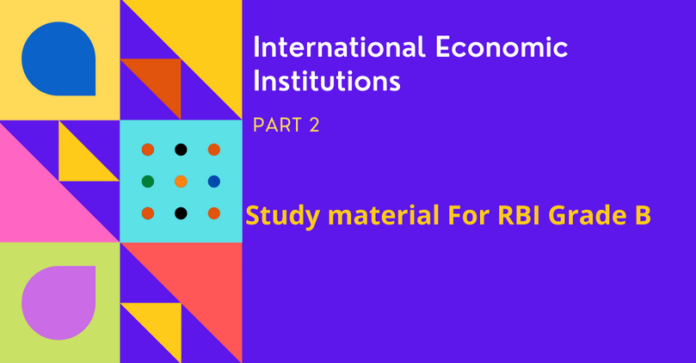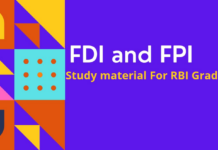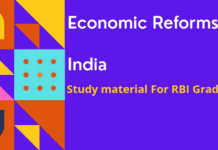The European Bank for Reconstruction and Development (EBRD)
The European Bank for Reconstruction and Development (EBRD) was founded in 1991 to create a new post-Cold War era in central and eastern Europe. It works across three continents – to further progress towards ‘market-oriented economies and the promotion of private and entrepreneurial initiative’.
- The EBRD is owned by 69 countries, as well as the European Union and the European Investment Bank.
- Acting President is Jürgen Rigterink
- Each shareholder is represented on the Board of Governors, which has overall authority over the EBRD. Its share capital is provided by its members
- Headquarter – London
CAF Development Bank of Latin America
CAF Development Bank, formerly known as the Corporacion Andino de Fomento, is a multilateral financial institution owned by 16 shareholder countries and 14 private banks in Latin America and the Caribbean, as well as Spain and Portugal. Established in 1970 in Caracas, Venezuela, CAF provides loans for purposes such as microfinance, infrastructure and health in Latin America and the Caribbean. It also provides financial advisory services and technical services.
The Islamic Development Bank
The Islamic Development Bank is a multilateral development bank (MDB), working to improve the lives of people by promoting social and economic development in Member countries and Muslim communities worldwide, delivering impact at scale.
- President: Dr. Bandar M.H. Hajjar
- Headquarters: Jeddah, Saudi Arabia
- Membership: 57 countries
European Investment Bank
The European Investment Bank is the lending arm of the European Union. It is the biggest multilateral financial institution in the world and one of the largest providers of climate finance. It was established in 1958 under the Treaty of Rome.
- President: Werner Hoyer
- Headquarters location: Luxembourg
In November 2019, the EIB’s Board of Directors demonstrated the EIB’s commitment to support the energy transition by adopting the new energy lending policy (ELP), which phases out EIB support to energy projects reliant on unabated fossil fuel by the end of 2021.
Asian Infrastructure Investment Bank
The Asian Infrastructure Investment Bank (AIIB) is a multilateral development bank with a mission to improve social and economic outcomes in Asia. Headquartered in Beijing, it began operations in January 2016 and has now grown to 103 approved members worldwide. It was promoted by the Government of China
- President: Jin Liqun
- The capital of the bank is $100 billion, equivalent to 2/3 of the capital of the Asian Development Bank and about half that of the World Bank.
- China will remain the biggest shareholder in the bank (India second largest), and the shares of non-Asian countries will be restricted to 25% of the total.
- China is the largest shareholder with 26.06% voting shares. India is the second largest shareholder with 7.5% voting shares
New Development Bank
At the fourth BRICS Summit in New Delhi (2012), the leaders of Brazil, Russia, India, China and South Africa considered the possibility of setting up a new Development Bank to mobilize resources for infrastructure and sustainable development projects in BRICS and other emerging economies, as well as in developing countries.
During the sixth BRICS Summit in Fortaleza (2014), the leaders signed the Agreement establishing the New Development Bank (NDB). In the Fortaleza Declaration, the leaders stressed that the NDB will strengthen cooperation among BRICS and will supplement the efforts of multilateral and regional financial institutions for global development, thus contributing to collective commitments for achieving the goal of strong, sustainable and balanced growth.
Fortaleza Declaration
“The Bank shall have an initial authorized capital of US$ 100 billion. The initial subscribed capital shall be US$ 50 billion, equally shared among founding members. The first chair of the Board of Governors shall be from Russia. The first chair of the Board of Directors shall be from Brazil. The first President of the Bank shall be from India. The headquarters of the Bank shall be located in Shanghai. The New Development Bank Africa Regional Center shall be established in South Africa concurrently with the headquarters.”
The bank will allow new members to join but the BRICS capital share cannot fall below 55%.
- Founder: BRICS
- Marcos Prado Troyjo
REGIONAL ORGANIZATIONS
SAARC
The South Asian Association for Regional Cooperation (SAARC) is the regional intergovernmental organization and geopolitical union of nations in South Asia. • It comprises of 8 member states include Afghanistan, Bangladesh, Bhutan, Pakistan, India, Nepal, Sri Lanka and Maldives.
• SAARC was founded in Dhaka conference in 1985.
• Its headquarter is based in Kathmandu, Nepal.
- It was initiated by President of Bangladesh Ziaur Rahman
- Secretary general: Esala Weerakoon
The main objectives of SAARC are to promote welfare of people of South Asia, accelerate economic growth and increase collaboration and mutual assistance in economic, social, culture, technology and scientific fields.
• South Asian Free Trade Area (SAFTA) was launched in 2006 under SAARC. 2010-2020 has been declared as “SAARC decade of Intra-regional Connectivity
Observers:
- Australia
- China
- European Union
- Japan
- Iran
- Mauritius
- Myanmar
- South Korea
- USA
ASEAN
ASEAN was established in August 1967 with the purpose of accelerating the economic growth, social progress, and cultural development in the region, and promoting regional peace and stability.
The Association of Southeast Asian Nations (ASEAN) is a regional grouping that promotes economic, political, and security cooperation among its ten members: Brunei, Cambodia, Indonesia, Laos, Malaysia, Myanmar, the Philippines, Singapore, Thailand, and Vietnam.
- Headquarters: Jakarta, Indonesia
- ASEAN Regional Forum (ARF) Membership- 27 members
- “ASEAN Plus Three” was founded in 1997 with People’s Republic of China, Japan, and South Korea to address mutual issues and concerns in energy security, natural gas development, oil market studies, renewable energy etc.
- ASEAN became ASEAN Plus Six with additional countries: Australia, New Zealand and India also known as Regional Comprehensive Economic Partnership (RCEP).
BIMSTEC
The Bay of Bengal Initiative for Multi-Sectoral Technical and Economic Cooperation (BIMSTEC) is a regional organization comprising seven Member States lying in the littoral and adjacent areas of the Bay of Bengal constituting a contiguous regional unity. This sub-regional organization came into being on 6 June 1997 through the Bangkok Declaration. It constitutes seven Member States: five deriving from South Asia, including Bangladesh, Bhutan, India, Nepal, Sri Lanka, and two from Southeast Asia, including Myanmar and Thailand. Initially, the economic bloc was formed with four Member States with the acronym ‘BIST-EC’ (Bangladesh, India, Sri Lanka and Thailand Economic Cooperation). Following the inclusion of Myanmar on 22 December 1997 during a special Ministerial Meeting in Bangkok, the Group was renamed ‘BIMST-EC’ (Bangladesh, India, Myanmar, Sri Lanka and Thailand Economic Cooperation). With the admission of Nepal and Bhutan at the 6th Ministerial Meeting (February 2004, Thailand), the name of the grouping was changed to ‘Bay of Bengal Initiative for Multi-Sectoral Technical and Economic Cooperation’ (BIMSTEC).
- Headquarters: Dhaka, Bangladesh
TPP
The Trans-Pacific Partnership (TPP), also called the Trans-Pacific Partnership Agreement, was a proposed trade agreement between Australia, Brunei, Canada, Chile, Japan, Malaysia, Mexico, New Zealand, Peru, Singapore, Vietnam, and the United States signed on 4 February 2016. After the newly elected US president Donald Trump withdrew the US signature from TPP in January 2017, the agreement could not be ratified as required and did not enter into force. The remaining countries negotiated a new trade agreement called Comprehensive and Progressive Agreement for Trans-Pacific Partnership, which incorporates most of the provisions of the TPP and which entered into force on 30 December 2018.
RCEP
The Regional Comprehensive Economic Partnership (RCEP) is a proposed agreement between the member states of the Association of Southeast Asian Nations (Asean) and its free trade agreement (FTA) partners. The pact aims to cover trade in goods and services, intellectual property, etc.
Member states of Asean and their FTA partners are Brunei, Cambodia, Indonesia, Laos, Malaysia, Myanmar, the Philippines, Singapore, Thailand, Vietnam, China, Japan, India, South Korea, Australia and New Zealand.
- The Regional Comprehensive Economic Partnership was introduced during the 19th Asean meet held in November 2011. The RCEP negotiations were kick-started during the 21st Asean Summit in Cambodia in November 2012. Now, all participating countries aim to finalise and sign a deal by November 2019.
- RCEP aims to create an integrated market with 16 countries, making it easier for products and services of each of these countries to be available across this region.
- On November 4, 2019 India decided against joining the 16-nation Regional Comprehensive Economic Partnership (RCEP) trade deal. Prime Minister Narendra Modi, in his speech at the RCEP Summit said “the present form of the RCEP agreement does not fully reflect the basic spirit and the agreed guiding principles of RCEP. It also does not address satisfactorily India’s outstanding issues and concerns in such a situation.”
European Union:
The European Union is a political and economic union between 28 countries
• The UK has voted to leave the European Union
• European Union aims to ensure free movement of people, goods, services and capital within the internal market of member countries and maintain common policies on trade, agriculture and regional development. The European Union is the largest trade block in the world.
Its headquarter is based in City of Brussels, Belgium.
The six founding countries are Belgium, France, Germany, Italy, Luxembourg and the Netherlands.
Shanghai Cooperation Organization (SCO):
The Shanghai Cooperation Organisation (SCO) is a permanent intergovernmental international organisation, the creation of which was announced on 15 June 2001 in Shanghai (China) by the Republic of Kazakhstan, the People’s Republic of China, the Kyrgyz Republic, the Russian Federation, the Republic of Tajikistan, and the Republic of Uzbekistan. Members – China, Kazakhstan, Kyrgyzstan, Russia, Tajikistan, Uzbekistan, India and Pakistan.
- It was preceded by the Shanghai Five mechanism.
- Its headquarter is based in Beijing, China.
- In 2017, India and Pakistan were admitted as full members.
- Official working languages of SCO are Chinese (Mandarin) and Russian
Asia Pacific Economic Cooperation (APEC):
Asia-Pacific Economic Cooperation (APEC) is a forum for 21 Pacific Rim member economies that promotes free trade throughout the Asia-Pacific region. It was established in 1989 in response to the growing interdependence of Asia-Pacific economies and the advent of regional trade blocs in other parts of the world. Its headquarter is based in Singapore. India was invited to be an observer for the first time in November 2011
Organization for Economic Cooperation and Development (OECD)
OECD is an intergovernmental economic organization of 36 countries, founded in 1961 to stimulate economic progress and world trade. The core mission of OECD is to promote policies that will improve the economic and social well-being of people around the world.
• Headquarters- Paris, France
G 7
G 7 is an international informal finance group consisting 7 industrialized nations Canada, France, Germany, Italy, Japan, the United Kingdom, and the United States.
G 20
G20 is an international forum for governments and central bank governors from 20 major economies. The G20 aims to discuss policy pertaining to the promotion of international financial stability. It was founded in 1999.
BRICS
BRICS is an acronym that refers to the economies of Brazil, Russia, India, China and South Africa, which are major developing economies of the world.
World Economic Forum
WEF is the foremost global community of business, political, intellectual and other leaders of society who are committed to improving the state of the world. WEF is an independent, not for profit organization that brings these leaders together to work on projects that improve people’s lives. It was established in 1971. Headquarter – (Cologny) Geneva, Switzerland
One Belt One Road (OBOR)
The brainchild of Chinese President Xi Jinping, is an ambitious economic development and commercial project that focuses on improving connectivity and cooperation among multiple countries spread across the continents of Asia, Africa, and Europe. Dubbed as the “Project of the Century” by the Chinese authorities, OBOR spans about 78 countries.
- Belt: The “One Belt” refers to the land-based “Silk Road Economic Belt”. Here Beijing aims to connect the country’s underdeveloped hinterland to Europe through Central Asia.
- Road: The “One Road” references the ocean-going “Maritime Silk Road”. It is to connect the fast-growing South East Asian region to China’s southern provinces through ports and railways.
- India is opposed to Chinese One Belt One Road (OBOR) initiative since the China-Pakistan Economic Corridor (CPEC) passes through the Indian territory.




